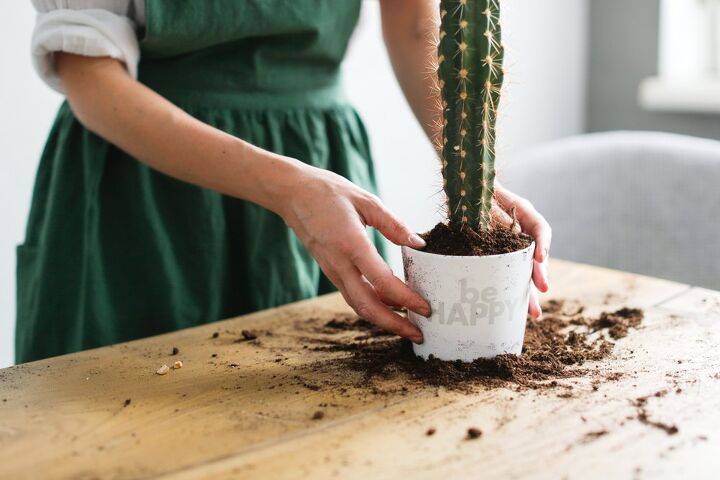How To Plant Cactus Cuttings (Step-by-Step Guide)

The cactus plant is known for being a staple of desert environments, but it also deserves a spot inside your home. The cactus plant can provide some fresh air of its own and its unique appearance is also a welcome sight.
Another thing to note about cacti plants is that they are remarkably resilient. Even a broken or cutaway piece of cactus can be used to grow the plant anew.
Take the cut and calloused over piece of cactus and place that into a container filled with pumice, soil, and compost. Make sure that the calloused end is buried one to two inches into the mixture. Place the pot in a sunny spot and water it regularly until it sprouts roots.
A cactus plant can make a fine addition to any home. Find out how to grow cacti plants and care for them by continuing with this article.
Why You Should Grow Cacti Plants at Home
Growing plants is becoming a more popular hobby and understandably so. Plants offer more fresh air, add a splash of green to your home, and bring a different dimension to home design. It also helps that they are not very demanding in terms of maintenance.
Cacti plants in particular are great choices as home additions. Their spiky appearance can serve as a great contrast to other design elements you have already. They also come in different sizes thus allowing you to use them as décor in different spots.
Perhaps the best argument for growing cacti plants at home is that it’s easy to do. The propagation process does not require a lot of work. After that, the plant itself will only require minor maintenance.
What Kind of Soil Mix Does a Cactus Plant Need?
The only somewhat troublesome part of propagating a cactus plant is gathering the soil mix needed. You cannot just use any kind of dirt for cacti. Animal manure is also not recommended because it can prevent the growth of the cuttings.
According to the University of Arizona, the ideal soil mix for succulents such as cacti contains inorganic and organic materials. To be more specific, you want there to be a blend of 50 percent inorganic and 50 percent organic materials.
Suggestions for the inorganic materials to be used include either pumice or perlite. As for the organic materials, you want either compost or peat mixed together with some soil. For a guide on creating compost at home, you can check out this article from the EPA.
That kind of mix is crucial because the inorganic and organic materials have roles to play. The organic materials are in charge of nourishing the plant while the inorganic materials improve aeration and drainage.
How to Grow a Cactus Cutting into a Full Plant
The process of growing a plant using a part of a separate but similar plant is known as propagation. We’ll lay out the process of propagating a cactus plant in this section of the article.
Step 1: Prepare the Materials for Propagation
To get things started, you’ll first need to prepare a few items. You’ll need a pot for the plant, the right soil mix mentioned earlier, and a knife.
Before using the knife, make sure to clean it thoroughly to prevent any spread of bacteria. As for the pot, make sure that it will fit the plant you’re growing. Refer to the cactus you’re cutting from to see how big the pot should be.
Step 2: Cut into the Cactus Plant
Where you make the cut depends on the type of cactus you have. If you have a columnar cactus, you need to make an angled cut along the stem. For a plant with pads, target the joint area between two pads for cutting.
Try to make the cut as clean as you can. If the cut turns out rough or jagged, make an additional cut until the surface is even.
Step 3: Wait for the Callus to Form
The cutting will not be able to sprout roots right after it was removed from the plant. A callus will have to form over the cut area first before it can be planted.
How long it will take the callus to form depends on the environment. Plenty of moisture and humidity in the air can prevent the callus from forming quickly. It could take over a week for the callus to form in that scenario.
In ideal conditions though, the cutting could have a completely formed callus in as little as four days.
Step 4: Get the Pot Ready for the Cactus Plant
After the long wait for the callus, you can now prep the pot for the cactus. Place the soil mix into the pot, but remember to leave the holes open. That will allow any water in the pot to drain faster.
Step 5: Place the Cutting into the Soil
It’s now time to dig up a hole for the cutting. How deep the hole should go will depend on what type of cactus you’re trying to root.
A taller cactus plant will need to be buried deeper. Dig a hole that’s about two inches deep for it. Place the callused end into the hole and then cover it up with the soil.
If the cactus plant is on the shorter side, the hole should only be about an inch deep. Make sure that the callused end is the one in the hole again and pack the soil firmly over it.
Step 6: Find a Good Spot for Your Cactus Plant
Next up, you have to find a spot where the cactus plant can grow. This is easier if you have some trees in your backyard. You can place the plant near a spot where a tree provides shade and it should grow well there.
Don’t fret if there’s no tree on your property though. You can still keep the plant near a window that gets a good amount of sunlight.
Step 7: Water the Cactus Plant
After setting the plant down in the right spot, remember to water it. You don’t have to soak the soil with water, but you should sprinkle enough to ensure the cutting is hydrated.
Step 8: Give the Cutting Time to Root
The last step of propagating the cactus plant will involve waiting for it to take root. Cacti plants don’t take a very long time to mature like trees do.
You should notice the cutting sprouting roots at about the two-week mark. Some cuttings may need more time though and it could take up to a month before they sprout.
Related Questions
Can You Propagate a Cactus Plant in Water?
Yes, soil is not the only suitable medium for growing a cactus plant. You can also rely on water to grow your cactus cutting. The steps for growing a cactus in soil and growing a cactus in water are pretty similar. Making the right cut is still important and so is waiting for the callus to form. The big difference of course is the planting medium.Instead of a pot with the right soil mix, you’ll need a container filled with water. Simply place the callused end into the water, but keep the leaves above the water.If you want to use a covering to keep the leaves from getting wet, go ahead and do so. Just make sure the stem has an opening to poke through. From there, you’ll just have to wait for the cutting to sprout like you would if it were planted in soil.
How often Should You Water Cacti Plants?
Even though you see them growing in deserts, cacti still need water to flourish. They don’t need a lot of it though. Watering once a week is enough even if temperatures are high in your area.It would be best to set a periodic reminder on your phone to check up on your plant. Although the cactus plant can survive for a while without water, you obviously don’t want to push it.
How Can You Tell if the Cactus Plant Is Getting Enough Sunlight?
Looking at the cactus plant itself should tell you right away if it’s receiving sufficient sunlight. Cacti plants that appear yellowish on one side are getting too much light on that spot. Find a different spot for them as soon as you spot the discoloration.Meanwhile, cacti plants that are starting to sprout small columns vertically are likely not receiving enough light. Remedy that situation right away by moving the plant to a better spot in your garden or home.

We are a team of passionate homeowners, home improvement pros, and DIY enthusiasts who enjoy sharing home improvement, housekeeping, decorating, and more with other homeowners! Whether you're looking for a step-by-step guide on fixing an appliance or the cost of installing a fence, we've here to help.
More by Upgraded Home Team




















![12 Washing Machine Brands to Avoid [with Recall Data]](https://cdn-fastly.upgradedhome.com/media/2023/07/31/9075781/12-washing-machine-brands-to-avoid-with-recall-data.jpg?size=350x220)






